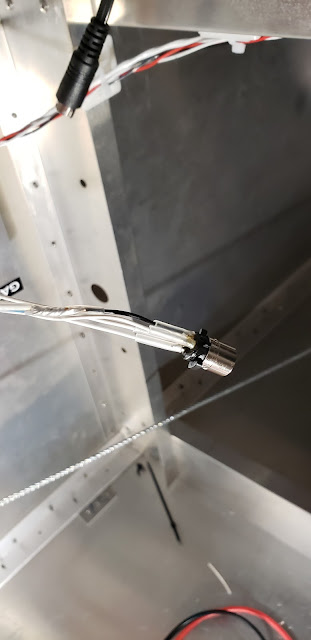4 hours
The ELT I'm using is an ACK E-04. I had previously created a mounting area just behind the baggage area and installed the little mounting tray there, but I hadn't realized that the mounting screws also needed to go through the two mounting straps. Luckily I was able to just reach way back there and undo the nuts, install the straps, and reinstall all the hardware. Then I could install the ELT into the tray and strap it down.
The wiring is pretty simple, it just has a 4-wire connector that consists of power, ground, a signal wire from the GPS box, and a "test" wire for verifying that the ELT is receiving the GPS position. It was tricky to solder the little connections in this area behind the seat, but once the connector is assembled it seems pretty sturdy.
The other cable on the front of the ELT is an RJ11 cable (same thing as a phone cord) that goes to a beeper and the remote control panel. I placed the beeper on top of the upper right longeron with two-sided tape, and I installed the control panel above the headset jacks using more of the same M3 screws that I used for the flap position sensor. The beeper and control panel both required special batteries. Annoyingly they need two different batteries, but the replacement interval is 10 years so I guess I won't have to go find replacements any time soon at least!
The last thing was to install the coax cable to the antenna. I used a 90-degree adpater at the antenna end, since clearance was tight next to the channel at the top inside of the turtledeck, where I installed the antenna previously. The other adapter in this picture is an anti-static filter that came with the ELT.
I used a few zip tie mounts to route the cable along the top channel up to the ELT. The included 5' cable ended up being just about the perfect length.
I didn't consider this way back when I built the mounting area for the ELT, but I put it a little too close to the turtledeck former, so there wasn't quite enough room for the coax cable to bend behind the former. I just drilled a hole for the cable to pass through and then curve towards the rear.











No comments:
Post a Comment